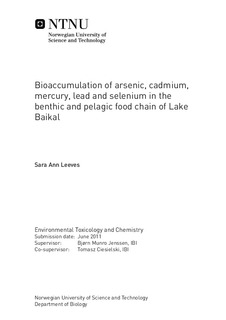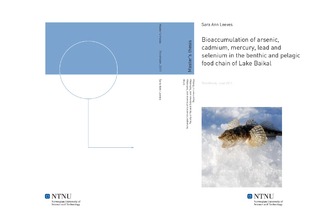| dc.description.abstract | Increased anthropogenic release of potentially toxic trace elements such as arsenic (As), cadmium (Cd), mercury (Hg), lead (Pb) and selenium (Se) into freshwater ecosystems over the past century has caused much concern. These elements are well known toxicants in aquatic ecosystems and may exert toxic effects even if present at relatively low concentrations in organisms. In this study, bioaccumulation of As, Cd, Hg, Pb and Se in the pelagic and benthic food chain of Lake Baikal have been investigated, with focus on the benthic and pelagic fish species. Concentrations of the selected trace elements have been analyzed in samples of water, plankton, benthic invertebrates and fish by High Resolution Inductively Coupled Plasma Mass Spectrometry (HR-ICP-MS). Concentration differences in the benthic and pelagic food chain of Lake Baikal have been investigated, with focus on benthic and pelagic fish species. In addition, spatial differences in the concentration of these potentially toxic elements between Selenga Shallows (possibly polluted site) and Listvyanka Bay (reference site) were included in the analysis to reveal potential anthropogenic impact on the lake.The comparative study revealed some concentration differences in water and biotic components at the two sampling locations. The concentration of Pb was significantly higher in water from the Selenga Shallows. However, several of the biota samples had highest concentrations of trace elements at Listvyanka Bay. This can be related to higher bioavailability of trace elements at Listvyanka Bay, possibly caused by lower abundance of natural ligands at this location. In both the pelagic and benthic food chain of Lake Baikal, Hg showed indication of biomagnification while As, Cd and Pb seemed to be biodiluted. When comparing fish inhabiting the pelagic and benthic food chain, differences in concentrations of As and Hg were identified. The As concentrations were twice as high in pelagic fish, while the benthic fish had seven times higher Hg content compared to pelagic fish. The observed concentration differences of As and Hg may be related to such as different complexity of the two food chains, different feeding strategies and habitat. Based on the tissue Se:Hg molar ratio there is no risk of Hg induced toxicity in the endemic fish species of Lake Baikal at the present. In general, the present study confirms low concentrations of potentially toxic chemical elements (As, Cd, Hg, Pb and Se) in Lake Baikal in comparison to other freshwater ecosystems. | nb_NO |

